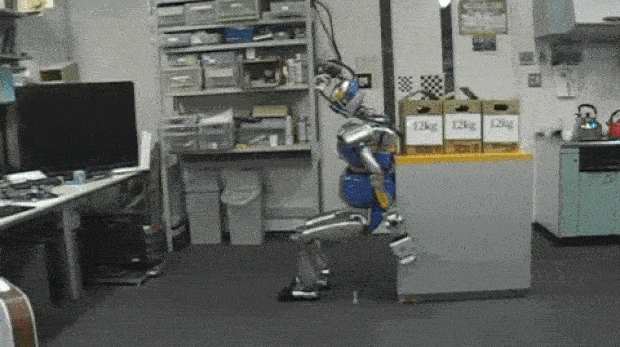The payload of a robot is a well-defined number that usually refers to how much mass its actuators or mobility system can comfortably support. The payload of a human works in a similar way, except that sometimes we can cheat, by offloading the mass of an object to the ground, and moving it purely by overcoming friction and shoving it along. For very heavy objects, doing this involves using the weight and stability of our whole bodies as well as our muscles, and robots are learning to do this, too.
At ICRA 2015 last week, researchers from University of Tokyo’s JSK Laboratory led by Professors Masayuki Inaba and Kei Okada presented a paper on “whole-body pushing manipulation with contact posture planning.” Or, shoving things. For humans, shoving things can be somewhat complicated, because there are a lot of different ways that a heavy object (like a big crate) can be shoved. You can put your shoulder against it and shove, put your hip against it and shove, or if it’s really heavy, lean against it with your back and shove with your legs.
The specific posture that you choose to shove something depends on what that thing weighs and how friction-y the bottom of it is, which are things that you usually don’t know before you start shoving. So what do you do? Well, you probably try shoving with your hands first, and then if it doesn’t move, you switch to a posture that allows you to exert more force.
The robot (an HRP-2) does the same thing: it pre-computes several different pushing postures that exert increasing amounts of force, and if it doesn’t sense the thing moving, it’ll autonomously try new strategies until it’s successful:
You’ll notice that the robot is pretty good at not falling over. This is autonomous also; it modifies its footsteps to be larger or smaller based on how far the object moves, which is detects through how much its body is tilting.
Next, the researchers plan to “apply the proposed method to other tasks with whole-body contact,” and your guess is as good as mine as to what those tasks are going to be.
“Whole-Body Pushing Manipulation With Contact Posture Planning of Large and Heavy Object for Humanoid Robot,” by Masaki Murooka, Shunichi Nozawa, Yohei Kakiuchi, Kei Okada, and Masayuki Inaba from the University of Tokyo, was presented at ICRA 2015 in Seattle, Wash.
Evan Ackerman is a senior editor at IEEE Spectrum. Since 2007, he has written over 6,000 articles on robotics and technology. He has a degree in Martian geology and is excellent at playing bagpipes.





